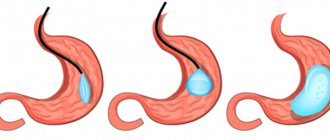Initial consultation by phone is free!
Psychiatric clinic phone number: +7 495 741–94–64
Eating disorders involve persistent disturbances in eating or eating-related behavior that
- Interferes with food intake or absorption
- Significantly impairs physical health and/or psychosocial functioning
Specific eating disorders include:
- Anorexia nervosa
- Selective eating disorder
- Compulsive overeating
- Neurogenic bulimia
- Parorexia
- Rumination disorder
Anorexia nervosa is characterized by an unrelenting desire for thinness, a morbid fear of obesity, a distorted image of one’s own body and restriction of food intake relative to the accepted norm; Moreover, all of these factors lead to very low weight, to such an extent that health is harmed. This disorder may or may not involve GI clearance (eg, self-induced vomiting).
Avoidance/restriction of food intake is characterized by avoidance of meals or food restriction that results in significant weight loss, nutritional deficiencies, dependence on nutritional support, and/or significant impairment of psychosocial functioning. But unlike anorexia nervosa and bulimia nervosa, this disorder does not involve concerns about body shape or weight.
Binge eating disorder is characterized by recurrent episodes in which people eat large amounts of food with a feeling of loss of control. Episodes do not alternate with cleansing procedures (eg, self-inducing vomiting).
Bulimia nervosa is characterized by recurrent episodes of binge eating followed by inappropriate compensatory behaviors such as purging (vomiting, laxative and diuretic abuse), fasting, or exercise.
Pica is the chronic use of non-nutritive, non-nutritive substances that are not developmentally appropriate (i.e., pica is not diagnosed in children <2 years of age) and is not part of cultural traditions.
Rumination is the repeated regurgitation of food after eating.
Eating disorders are more common among women, especially young women, than among men.
Initial consultation by phone is free!
Phone:+7 495 741–94–64
Anorexia nervosa is characterized by an unrelenting desire for thinness, a morbid fear of obesity, a distorted image of one’s own body and restriction of food intake relative to the accepted norm; Moreover, all of these factors lead to very low weight. The diagnosis is made on the basis of clinical data. Treatment mainly consists of psychotherapy and behavioral therapy. Family involvement is critical to care for younger patients. Olanzapine helps increase body weight.
Anorexia nervosa mainly develops in girls and young women. The disorder usually begins in adolescence and rarely after age 40.
There are two types of anorexia nervosa:
- Restrictive: Patients limit their food intake, but suffer from compulsive overeating and do not resort to stomach cleansing as with bulimia; some patients resort to excessive physical activity.
- Cleansing: patients constantly overeat and then induce vomiting and/or use laxatives or diuretics, or perform enemas.
Bulimia is defined as eating much more food than most people eat in a similar period of time under similar circumstances with loss of control.
Etiology
The etiology of anorexia nervosa is unknown.
In addition to female gender, several risk factors have been identified. In Western society, obesity is considered unattractive and unhealthy, and the desire to be thin is common, even among children. More than 50% of prepubertal girls diet or take other measures to control their weight. Excessive concerns about weight or a history of dieting seem to indicate an increased risk, and there is also likely some genetic predisposition. Studies of monozygotic twins have shown concordance <50%; it is lower in dizygotic twins.
Family and social factors may play some role. Many patients belong to the middle or upper socioeconomic class; they are pedantic, prone to obsessive behavior, have an average level of intelligence and set very high standards for achievement and success.
Pathophysiology
Endocrine disturbances are common in anorexia nervosa; these include:
- Low levels of sex hormones
- Moderately reduced levels of thyroxine (T4) and triiodothyronine (T3)
- Increased secretion of cortisol
Menstruation usually stops, but such cessation is no longer a criterion for diagnosis. Bone mass decreases. In patients with severe malnutrition, virtually every major organ system may be affected. However, susceptibility to infection generally does not increase.
Dehydration and metabolic alkalosis, decreased serum potassium and/or sodium levels often develop; these phenomena are aggravated by inducing vomiting, taking laxatives and diuretics.
There is a decrease in myocardial mass and cardiac output. Such patients often experience mitral valve prolapse. Some patients experience prolongation of the QT interval (even after adjustment for heart rate), which, in combination with electrolyte imbalance, increases the likelihood of developing tachyarrhythmias. Sudden death is possible, most often due to ventricular tachyarrhythmia.
Clinical manifestations
Anorexia nervosa can be mild and short-lived, but there are cases of severe and intractable disease.
Despite being underweight, most patients are concerned that they weigh too much or that certain parts of their body (eg, thighs, buttocks) are too fat. They persist in trying to lose weight despite reassurances and warnings from friends and family that they are thin or even significantly underweight, and they view any weight gain as an unacceptable failure of self-control. The patient's concern and anxiety about his weight continues to increase even as he becomes malnourished.
The term "anorexia" is not entirely accurate, since the appetite often persists until the patient reaches a serious stage of exhaustion. Patients show concern about their food:
- They can study different diets and count calories.
- They may hoard, hide or throw away food.
- They can collect various recipes.
- They can prepare complex dishes for other people.
Patients often verbally exaggerate the amount of food they consume and hide abnormal behavior such as vomiting. Bulimia occurs in 30–50% of patients. Other patients simply limit their food intake.
Many people with anorexia nervosa engage in excessive exercise to control their weight. Even patients who tend to be malnourished usually maintain a high level of activity (including vigorous exercise).
Patients often complain of bloating, abdominal discomfort, and constipation. Libido usually decreases sharply. The development of depression is often observed.
Patients experience bradycardia, decreased blood pressure, hypothermia, the appearance of vellus hair or mild hirsutism, and edema. Adipose tissue mass is greatly reduced. Patients who vomit frequently may experience damage to tooth enamel, painless enlargement of the salivary glands, and/or inflammation of the esophagus.
Anorexia symptoms
One of the most basic symptoms is loss of human body weight, as well as loss of appetite. If anorexia occurs in teenage girls, the symptoms also include disruption of the menstrual cycle. The patient feels constant weakness, sleep is disturbed, arrhythmia, amenorrhea occurs, and there may also be muscle spasms. The most important point in treating the disease may be the patient’s reluctance to tell doctors the truth about the weight loss methods and diets that the patient used. It is worth noting that the initial stage is characterized by the patient’s complexes due to his completeness and various ways to eliminate this problem.
If parents notice that their young child is rapidly losing weight, this should alert them.
The following symptoms of anorexia are distinguished:
- lack of appetite, depressed state,
- Bad mood,
- insomnia.
The condition of the nails worsens, menstruation disappears or becomes irregular, the face becomes pale with large circles under the eyes. In addition, the body, without receiving the necessary nutrients, lives in a state of constant stress.
There are many factors that lead to anorexia. This may be an unhealthy mental climate in the family, low self-esteem, a negative attitude towards food that arose in childhood, perfectionism, that is, the desire to be the first, the best in everything, and others.
In addition, anorexia can lead to:
- anemia,
- intoxication of the body,
- diabetes,
- hormonal and other disorders.
Regardless of the nature of the disorder, it requires professional treatment. Subspecialty specialists - psychotherapists, psychologists and psychiatrists - know well how to treat anorexia.
Diagnostics
- Clinical criteria
Failure to acknowledge the seriousness of low body weight and restricted nutrition are characteristic features of anorexia nervosa. Patients refuse to undergo assessment and treatment; As a rule, they are brought to the doctor by family members or they see the doctor for another disease.
Clinical criteria for a diagnosis of anorexia nervosa include the following:
- Restricting food intake, which results in a significant reduction in body weight
- Fear of excessive weight gain (manifested as a direct statement from the patient or as a behavior that prevents weight gain)
- Body image distortion (misperception of weight and/or body appearance) or denial of the severity of the illness
In adults, the degree of weight loss; a BMI < 17 kg/m2 is considered significantly low; A BMI of 17 to <18.5 kg/m2 can also be considered quite low, but this depends on the patient’s initial weight.
For children and adolescents, age-specific BMI percentile is used; The 5th percentile is generally considered borderline. However, children above the 5th percentile who do not meet the height prediction schedule may also be considered for meeting the low weight criterion; The US Centers for Disease Control and Prevention (CDC) publishes tables of age-specific BMI percentiles and standard height charts. Special calculators for calculating BMI are available for children and adolescents.
Patients may otherwise feel well and have few, if any, abnormal blood tests. The key to diagnosis is the identification of persistent active efforts to avoid weight gain and intense fear of obesity that does not improve with weight loss.
Differential diagnosis
Another mental disorder, such as schizophrenia or primary depression, may lead to weight loss and food reluctance, but these disorders are not associated with anorexia nervosa and patients with these disorders do not have a distorted body image.
In rare cases, an undiagnosed severe medical disorder may be the cause of weight loss. These disorders may include malabsorption syndromes (for example, as a consequence of inflammatory bowel disease or celiac disease), new-onset type 1 diabetes, adrenal insufficiency, and cancer. Similar symptoms can develop due to amphetamine abuse.
Persuasion will not help: why should a psychiatrist treat anorexia and bulimia?
Date of publication: 03/03/2020 Articles
Significant weight loss, refusal to eat, constant dissatisfaction with one’s body, a depressed state... Often relatives do not notice the appearance of alarming symptoms of anorexia in a loved one. And if they do notice, they underestimate their danger, believing that there is nothing easier than persuading a person to start eating again. But this misconception is a fatal mistake: anorexia causes irreparable harm to health and can have the most dire consequences, so only a doctor should treat it.
What is anorexia nervosa
Anorexia nervosa is an eating disorder characterized by a constant desire to lose weight, a distorted idea of the proportions of one’s body, a pathological belief in the presence of body defects, a panicky fear of obesity, and a complete or partial refusal to eat.
“Anorexia nervosa is a serious and sometimes difficult to treat mental illness that changes a person’s consciousness, often threatening his life,” notes Yuri Shikin, head of the 14th women’s general psychiatric department of the Stavropol mental hospital. – The belief that one has any physical defects is often at a painful, almost delusional level.
A brochure from the National Institute of Mental Health (a large US research organization specializing in the study of mental health problems) states: “Anorexia nervosa has the highest mortality rate of all mental disorders.”
Why and at what age can anorexia appear?
“The causes of anorexia have not yet been clarified,” says Yuri Shikin. – There are only certain ideas about them that lie on the surface: the widespread fashion for slim and thin people, the desire to follow certain standards imposed by the media.
Teenagers experience their compliance and non-compliance with these standards especially painfully. At risk, according to a Stavropol psychiatrist, are people aged 13-14 to 25-26 years, 95% of whom are girls.
At the end of last year, according to RIA Novosti, the head of the department of statistics of living standards and household surveys of Rosstat, Elena Frolova, said: “2.5% of adolescents suffer from excessive thinness, according to our data, and for children aged 0 to 5 years this figure is about 3%. The global figure for all countries is 7.7%, that is, in our country it is noticeably lower.” These data were obtained from the results of a sample study of the nutrition of Russians in 2021, conducted by the department.
– At an older age, this level of disorders gradually disappears. A person with anorexia closer to 30 years of age is already a rarity,” says Yuri Mikhailovich. – This means that there is a connection to a certain period of personality development.
In adolescence and young adulthood, the very turning point often occurs that can give impetus to the development of the disease. Therefore, it is so important for parents not to miss the appearance of the first symptoms of anorexia in their child and to seek help in time.
How to recognize anorexia and bulimia
It is believed that anorexia and a regular diet are similar. But that's not true. An eating disorder can be noticed immediately. A person first begins to sharply limit himself in food, drinks diuretics and laxatives, and exhausts his body with training. When he does not achieve the desired result, he goes further - he induces vomiting after every lunch and dinner. And at a certain moment, consciousness loses control over behavior, and a state of extreme exhaustion sets in, threatening life.
“When such trouble comes to a family, close people should immediately react and sound the alarm,” notes Yuri Shikin.
Important! Parents should be wary of the following in their child’s behavior:
- Suddenly he began to eat little or stopped altogether.
- Loses weight quickly.
- Stopped eating in front of everyone, avoids communal feasts.
- After eating, retire to the toilet or bathroom.
- She talks a lot about her unattractiveness and imperfect figure.
- His idea of the shortcomings of his own body sharply diverges from the objective picture of his appearance.
A person suffering from anorexia does not realize that he is sick. He explains his behavior simply: I am overweight, and every meal becomes the cause of “disfiguring” obesity. According to Yuri Mikhailovich, patients often say: “As soon as you look at the water or eat a spoonful of porridge, you immediately feel as if your whole body is filled with fat, which is impossible to get rid of.”
Another disorder accompanied by painful feelings of physical inferiority is bulimia. Refusal to eat can be replaced by an irresistible desire to eat a lot. And then a person begins to consume food without control over its quality and without a feeling of fullness. This need dulls consciousness. A person eats, induces vomiting, then eats again - and so on, up to 2-3 times a day, up to 10-20 times a day. This cycle can often take the entire day, exhausting and exhausting the body.
It’s important not to miss
It is important to understand that anorexia is not a whim, not stubbornness or a desire to show character. Therefore, persuading or waiting for a person to start feeding himself is pointless. Experience shows that neither the method of suggestion nor the method of violence (parents trying to force the child to eat) can solve anything.
– Early treatment is very important in treating the disease. The earlier the disease is diagnosed, the greater the chances of a positive outcome. At the first stage, when experiences associated with one’s own physical unattractiveness only appear and the first attempts are made to limit nutrition, psychotherapeutic assistance is effective. Individual, consistent, clear, persistent, sometimes with some emotional pressure.
If it is not possible to recognize anorexia at an early stage, it develops into more severe forms, and then treatment takes place in a psychiatric hospital or intensive care unit with strict regime conditions and forced feeding. Such a patient should be in an institution where there is round-the-clock monitoring and control, where they can restore his health.
The main task of loved ones is not to reach this stage and contact a psychiatrist in time. But take into account that a patient with anorexia perceives treatment as punishment and the desire of others to make him a fat and ugly person. Therefore, in the interests of the patient, it is necessary to overcome his resistance and reluctance to be treated.
Read our other articles
Watch and read us on social networks
Illustrations for this publication are taken from the public image library https://www.freepik.com/ and from open sources.
You can read in detail about using illustrations from the Freepik library here
Forecast
Mortality is high, approaching 10% per decade among patients brought to clinical attention; undiagnosed mild disease is likely to rarely lead to death. With treatment, the prognosis is as follows:
- In half of the patients, it is possible to restore body weight to a large extent or completely and compensate for endocrine and other complications.
- About a quarter of patients may experience relapses of the disease.
- Another quarter of patients develop persistent somatic and mental complications during relapses
Children and adolescents treated for anorexia nervosa have better outcomes than adults.
Symptoms and signs of anorexia in adults
Entering adulthood can be a strong stress factor for a person who has prerequisites for an eating disorder with developed addictive behavior. By this time, a person’s weight can decrease by 20–50% of normal, and therefore the symptoms of anorexia in adults become obvious, almost completely developing the picture of the disease.
Symptoms of anorexia in adults include:
- fast fatiguability;
- dizziness, fainting;
- decreased heart rate;
- low blood pressure;
- damage to blood vessels on the face;
- puffiness of the cheeks;
- hair loss;
- dry skin;
- body hair growth;
- cessation of menstruation;
- lack of sexual desire;
- gastrointestinal disorders.
Symptoms of anorexia in adults at the final stage include irreversible degeneration of internal organs, protein-free edema, lack of subcutaneous fat, trophic changes in the skin and muscles, and myocardial dystrophy. Serious failures appear on the part of internal organs and systems. However, against the backdrop of extreme exhaustion, such people continue to refuse food, considering themselves fat.
Treatment
- Enriched nutrition
- Psychotherapy (eg, cognitive behavioral treatment)
- Treatment of children and adolescents is carried out at home
- Sometimes 2nd generation antipsychotics
Treatment for anorexia nervosa may require short-term intervention to restore weight to save the patient's life. In case of rapid or severe weight loss, when body weight is reduced by more than 75% of the recommended value, it is necessary to urgently restore weight, and for this purpose the possibility of hospitalization of the patient should be considered. If any doubt arises, patients should be hospitalized.
Outpatient treatment may include varying degrees of support and supervision, usually provided by a team of practitioners.
Nutritional support is often prescribed in conjunction with behavioral therapy, which has clear goals for weight restoration. Nutrition replacement starts at 30-40 kcal/kg/day; this can provide a weight gain of 1.5 kg/week during hospitalization and 0.5 kg/week during outpatient treatment. Oral feeding of solid foods is most preferred, but many weight loss programs also use liquid supplements. Treatment-resistant, malnourished patients sometimes require nasogastric feeding.
Elemental calcium 1200 to 1500 mg/day and vitamin D 600 to 800 IU/day are commonly prescribed to treat osteoporosis.
After stabilization of food, fluid and electrolyte balance, a long course of rehabilitation begins. The basis of treatment is outpatient psychotherapy. Behavioral outcomes, such as normalization of diet and weight, should be of particular importance in treatment. Treatment should continue for a year after weight has been regained. The best results are achieved in adolescents who have had this disorder for less than 6 months.
For adolescents, a good effect is achieved against the background of family psychotherapy, in particular using the Maudsley method (the so-called family treatment). This model has 3 phases:
- Family members are taught how to properly feed the adolescent (eg, through supervised family meals) and restore the adolescent's body weight (unlike earlier methods, this model does not place blame for the development of the disorder on the family or the adolescent).
- Gradually, control over a teenager’s nutrition decreases.
- Once the teenager is able to independently maintain the restored weight, therapy is aimed at developing a healthy personality for the teenager.
Treatment of anorexia nervosa is complicated by patients' fear of gaining weight and denial of their illness. The doctor must establish a calm, trusting, stable relationship with the patient, strongly recommending appropriate calorie intake.
Treatment also involves regular follow-up, and often follow-up with a team of doctors, including a dietitian, who can provide specific meal plans or information about the calories needed to restore weight to normal levels.
Despite the priority of psychotherapy, drug treatment can also be effective. Second-generation antipsychotics (eg, olanzapine up to 10 mg orally once a day) help with weight gain and reduce anxiety.
Anorexia nervosa: treatment
The following are the main stages of treatment for anorexia:
1. It is imperative that you immediately consult a doctor, since anorexia nervosa can lead to the development of a number of serious complications:
- infertility;
- heart rhythm disturbance;
- pancreatitis;
- stomach ulcer and a number of others.
2. If the patient refuses to eat, force feeding through a tube and administering nutrients intravenously to increase body weight and compensate for nutritional deficiencies.
3. Consultation with a psychotherapist.
4. Placing the patient in a hospital to control his diet and prevent relapses and breakdowns.
5. If the cause of anorexia is other diseases (tumors, chronic infections, tuberculosis, etc.), then the underlying disease is treated first.
In our online store we offer you the following drugs for the treatment of anorexia nervosa, which can be used as part of complex therapy for this disease:
- Complex B-50;
- L-Carnosine;
- Beta-Carotene;
- Bromelain;
- MultiVita;
- Super Enzymes;
- L-Phenylalanine;
- OsteoComplex;
- Floraldophilus and a number of others.
Before using any drug, you should consult your doctor.
Basic provisions
- Patients with anorexia nervosa suffer from an intense fear of gaining weight or becoming fat, which persists despite clear evidence to the contrary.
- With the restrictive type of anorexia nervosa, patients limit their food intake and sometimes resort to excessive physical activity, but do not regularly transmit or resort to stomach cleansing.
- With the purgative type of the disease: patients often overeat and then induce vomiting and/or use laxatives or diuretics or perform enemas in order to cleanse themselves of the food they have eaten.
- In adults, BMI is significantly lower, and in adolescents, the BMI percentile is low or does not increase as expected for normal height.
- Physical abnormalities are common and death may occur.
- Treatment through intrapersonal support, psychotherapy (eg, cognitive behavioral therapy), and, in the case of adolescents, family therapy; 2nd generation antipsychotics (eg, olanzapine) may be effective.
Initial consultation by phone is free!
Phone:+7 495 741–94–64
Bulimia nervosa is characterized by recurrent episodes of binge eating followed by inappropriate compensatory behaviors such as purging (vomiting, laxatives or diuretics), fasting, or intense exercise; episodes occur on average at least once a week for 3 months. Diagnosis is based on the study of anamnesis and the results of a clinical examination. Treatment consists of psychotherapy and antidepressants.
Bulimia nervosa occurs in 1.6% of adolescents and young women, and in 0.5% of men of the same age. All patients are overly concerned with the weight and shape of their body. Unlike people with anorexia nervosa, people with bulimia nervosa usually weigh within the normal range or more.
Pathophysiology
Sometimes serious disturbances of water and electrolyte balance develop, in particular hypokalemia. In extremely rare cases, the stomach or esophagus may rupture during an episode of overeating or induced vomiting, leading to life-threatening complications.
Since this condition is not characterized by weight loss, the serious physical complications that often occur with anorexia nervosa are virtually non-existent. However, cardiomyopathy can develop as a result of long-term use of ipecac syrup if it is used to induce vomiting.
Clinical manifestations
Patients with bulimia nervosa typically describe alternating episodes of binge eating followed by purging. Overeating involves eating an amount of food that is significantly greater than what most people would consume over the same period of time under similar circumstances (although the assessment of the excessive amount of food eaten during a regular meal compared to a holiday feast may vary), and is accompanied by a feeling of loss of control above oneself.
During episodes of overeating, patients prefer to eat sweets and foods high in fat (eg, ice cream, cakes). The amount of food consumed varies greatly and can reach several thousand calories. Overeating is usually episodic, often triggered by psychosocial stress, can occur several times a day and, as a rule, in secret from others.
Overeating is followed by compensatory behavior: provoked vomiting, use of laxatives or diuretics, increased exercise and/or fasting.
Typically, the weight of patients is within normal limits; a minority are overweight or obese. However, patients are overly concerned about their own body weight and/or shape; they are often unhappy with their body and think they need to lose weight.
In general, compared with patients with anorexia nervosa, patients with bulimia nervosa are more aware of their behavior and feel more regret or guilt about it; they are more likely to admit their experiences when interviewed by a sympathetic clinician. They are less socially isolated and more likely to act impulsively, take drugs, abuse alcohol, and develop overt depression. Anxiety (eg, regarding weight and/or social situations) and anxiety disorders may be more common in these patients.
Complications
Most physical symptoms and complications occur as a result of cleansing procedures. Inducing vomiting can lead to erosion of the tooth enamel of the incisors, painless enlargement of the parotid (salivary) glands and the development of esophagitis. Physical signs include:
- Enlarged parotid glands
- Scars on the bones (from repeated initiation of the gag reflex using the fingers)
- Erosion of tooth enamel
Diagnostics
- Clinical criteria
Clinical criteria for diagnosing bulimia nervosa include the following:
- Recurrent episodes of binge eating (uncontrolled consumption of an unusually large amount of food), which are accompanied by a feeling of loss of control over food intake and occur on average once a week for 3 months
- Recurrent episodes of inappropriate compensatory behavior aimed at changing body weight (on average, at least once a week for 3 months)
- Self-esteem that is overly dependent on body shape and weight
Diagnosis of anorexia nervosa
The diagnosis of anorexia is made on the basis of a survey and examination of the patient, confirmed by laboratory and instrumental studies.
During the examination, the doctor pays attention to the following signs:
- the patient's weight is constantly reduced by at least 15% of normal body weight;
- the patient has an obsession about being fat, although in fact his weight is below normal;
- weight loss is caused by the patient himself, by going on diets, taking diuretics, laxatives, and inducing vomiting after eating.
Laboratory research:
- blood test for thyroid hormones - in anorexia their levels are reduced;
- blood sugar test - glucose level less than 3.3 mmol/l.
In addition, a brain CT scan may be prescribed to exclude tumor diseases, as well as a consultation with a gynecologist to exclude other causes of amenorrhea.
Treatment
- Cognitive Behavioral Therapy (CBT)
- Interpersonal psychotherapy (IPP)
- SSRIs
CBT is the treatment of choice for bulimia nervosa. Typically treatment consists of 16–20 individual sessions over 4–5 months; therapy can also be group. Treatment is aimed at
- Increasing motivation for change
- Replacing dysfunctional eating with a regular and flexible schedule
- Reducing undue preoccupation with body shape and weight
- Preventing relapse
CBT can eliminate episodes of overeating and gastrointestinal cleansing in 30–50% of patients. Some patients do not complete the full course of treatment, and some do not respond to treatment. Once improvement is achieved, it persists for quite a long time.
In MLP, the emphasis is on identifying personality problems that may trigger the development of an eating disorder. Treatment focuses directly on managing the symptoms of the eating disorder. MLP can be considered as an alternative treatment method when CBT is not possible.
SSRIs are used to reduce the frequency of overeating and vomiting, although the long-term effects of their use are not yet known. SSRIs are also effective for treating symptoms of anxiety and depression. For the treatment of bulimia nervosa, fluoxetine 60 mg orally once a day is recommended (this dose is higher than that usually used for depression).
Types of anorexia according to clinical signs
When classifying nervous disorders, psychiatrists take into account clinical manifestations. According to this criterion, three types of anorexia are distinguished. First, an eating disorder with monothematic body dysmorphic disorder. In this case, the patient really wants to lose weight, uses any means to do this: diets, sports, eating only low-calorie foods, abuse of laxatives, diuretics, and medications to suppress appetite.
Secondly, there is disordered eating behavior, when periods of anorexia are replaced by bulimia. Such patients do not receive treatment from a psychiatrist soon, because due to bouts of overeating, critical weight loss is not observed for a long time. Thirdly, the disease can be combined with bulimia and vomitomania. After the overeating stage, a person induces vomiting as a measure of weight correction. This greatly depletes the body.
Basic provisions
- Bulimia nervosa is characterized by recurrent episodes of binge eating followed by inappropriate compensatory behavior, such as inducing vomiting, using laxatives and diuretics, fasting, or intense exercise.
- Unlike patients with anorexia nervosa, patients with bulimia nervosa rarely experience significant weight loss or develop nutritional deficiencies.
- Periodic vomiting can lead to erosion of tooth enamel and/or cause esophagitis.
- Treatment uses cognitive behavioral therapy and sometimes SSRIs.










